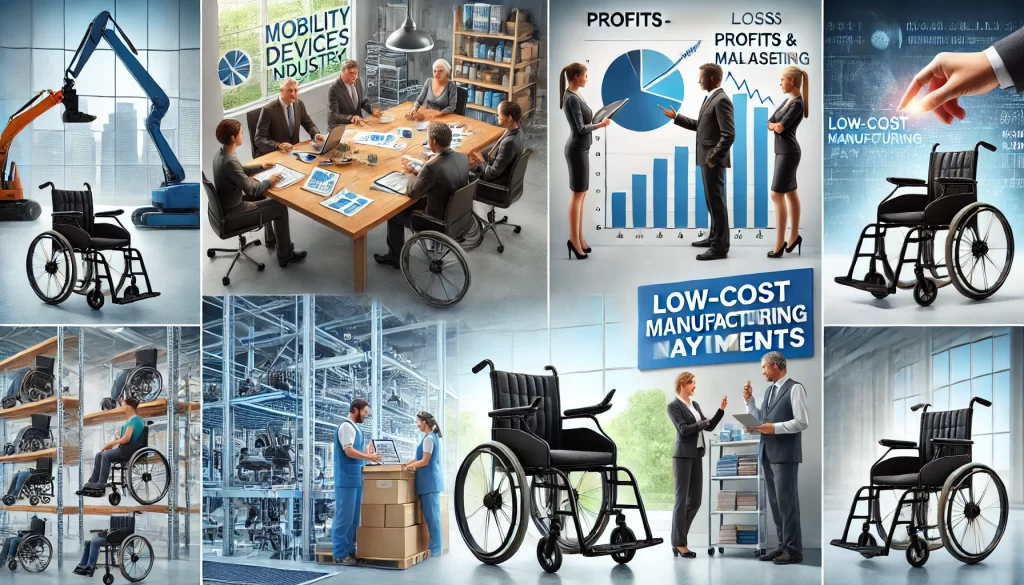Industry Profits and Losses
The mobility devices industry, which includes products such as wheelchairs, scooters, walkers, and canes, is experiencing significant growth. This growth is driven by an aging population, increasing chronic diseases, and technological advancements. Here’s an in-depth look at the financial landscape of this industry:
Revenue and Growth:
- Market Size: The global mobility aids market was valued at USD 7.98 billion in 2020 and is expected to reach USD 11.9 billion by 2027, growing at a CAGR of 6.1% from 2021 to 2027 (Grand View Research) (Grand View Research).
- Profit Margins: Profit margins vary significantly across different segments. High-tech devices like electric wheelchairs and mobility scooters typically have higher margins due to their advanced features and higher prices. Manual wheelchairs and basic mobility aids often have lower margins but higher volume sales.
Challenges:
- R&D Costs: High research and development costs for new technologies can impact profitability. Companies must balance innovation with cost control.
- Regulatory Compliance: Meeting regulatory standards in different countries can be costly and time-consuming.
- Reimbursement Rates: Changes in healthcare reimbursement rates, especially from Medicare and Medicaid, can impact profitability. Lower reimbursement rates can squeeze margins.
Opportunities:
- Technological Advancements: Innovations such as smart wheelchairs and advanced materials can lead to higher-margin products.
- Emerging Markets: Expanding into emerging markets can provide new revenue streams and growth opportunities.
Finding Low-Cost Manufacturing Suppliers
To maintain profitability, mobility device companies often seek low-cost manufacturing options. Here are steps to find reliable suppliers:
- Research and Networking:
- Industry Directories: Use industry directories like ThomasNet and GlobalSources to find manufacturers.
- Trade Shows: Attend industry trade shows such as Medtrade or REHACARE to meet potential suppliers.
- Evaluate Suppliers:
- Quality Control: Ensure the supplier adheres to quality standards. Request samples and conduct factory audits if possible.
- Certifications: Verify that the supplier has necessary certifications, such as ISO 9001 for quality management systems.
- Cost Analysis:
- Compare Quotes: Obtain quotes from multiple suppliers and compare costs, including shipping and tariffs.
- Total Cost of Ownership: Consider the total cost, including logistics, quality control, and potential for rework or defects.
- Long-term Relationships:
- Build Relationships: Develop strong relationships with suppliers to negotiate better terms and ensure reliable supply.
High Insurance Payment Details
Insurance payments for mobility devices can vary widely depending on the type of device, the patient’s condition, and the insurer. Here’s how to navigate insurance payments:
- Understand Insurance Coverage:
- Medicare: Medicare Part B covers mobility devices deemed medically necessary by a doctor. The patient typically pays 20% of the Medicare-approved amount, and Medicare pays the remaining 80% (Centers for Medicare & Medicaid Services).
- Medicaid: Coverage varies by state, but Medicaid generally covers a wide range of mobility devices. States have different processes for prior authorization and reimbursement.
- Documentation and Coding:
- HCPCS Codes: Use the correct Healthcare Common Procedure Coding System (HCPCS) codes for billing. Common codes include E0100 (walker, rigid, wheeled, or folding), E0143 (crutches, underarm, articulated, spring-assisted), and K0001 (standard wheelchair) (Centers for Medicare & Medicaid Services).
- Medical Necessity Documentation: Ensure proper documentation from the prescribing physician, including detailed medical necessity letters and patient evaluations.
- Billing Process:
- Submit Claims: Submit claims to the insurer with all required documentation. Follow up regularly to ensure timely processing.
- Appeal Denials: If a claim is denied, review the denial reason and file an appeal with additional supporting documentation.
Helpful Links:
- Medicare Coverage: Medicare.gov – Durable Medical Equipment
- Medicaid Programs: Medicaid.gov – State Overviews
- HCPCS Codes: CMS HCPCS Coding
By understanding the financial dynamics, sourcing strategies, and insurance billing processes, companies in the mobility devices industry can navigate challenges and seize opportunities for growth and profitability.




